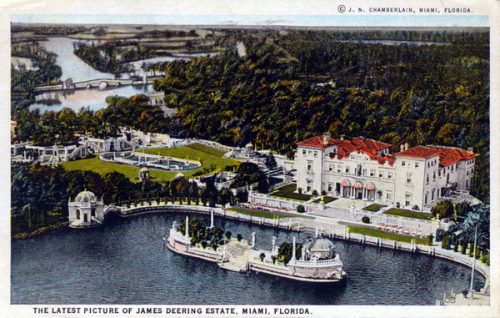Travels with Grace: Florida, 1925 Part 2
Welcome to this week’s segment of our 2019 #TravelTuesday series: Traveling with Grace. Today Grace continues her trip through Florida, exploring Palm Beach, Miami, and their environs.
From Daytona to W. Palm Beach
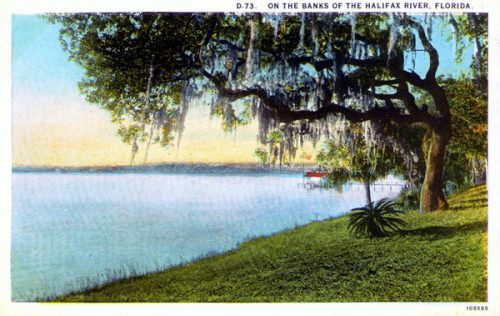
On the banks of the Halifax River – Florida. 1925. (State Archives of Florida)
March 10, 1925: Left Daytona at 8 a.m. in the VanDyke bus. Rode along beside the Halifax and Indian Rivers past Cocoa, Rockledge, Melbourne where we stopped for lunch, Vero, Titusville, Ft. Pierce and Stuart, all picturesque, endowed with citrus groves and tropical flowers and foliage facing the water and screened from it by fingers of palms. At intervals of a few yards are little piers to which small boats are moored. The people look happy, lazy and comfortable rocking on their porches or beneath the trees. It costs little to live here and therefore work is discouraged. Everybody is either eating or taking a siesta. The principal industries are fruit packing and catering to the tourist hence the surprisingly large number of spacious and fine hotels. We bought some delicious oranges, tangerines and kumquats along the way.
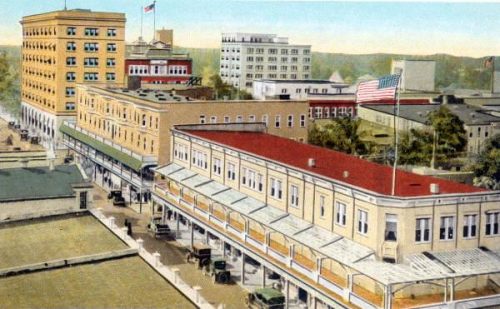
West Palm Beach, Fla., from El Verano Hotel. 1924. (State Archives of Florida)
The main roads are good but there are so many detours because road building, which is done for the most part by state prisoners, is a slow process here where the rains wash away the sandy foundation as quickly as it is graded and before they have a chance to put on the hard surface. Crushed coral and coquina are used in the cement. As we near West Palm Beach where we arrived at 6 p.m. it grows much warmer. We came to the El Verano Hotel very pretty and modern with beautiful shops on the ground floor. The town looks crowded and busy. After dinner we rested on the broad piazza outside of the dining room on the 2nd floor, overlooking Lake Worth with its myriads of twinkling lights and hundreds of small pleasure craft. Palm Beach and the Royal Ponciana are directly opposite. There was music until a late hour, and we watched the gayley dressed throng dancing on the porch. A full moon shed it glow over all.
Palm Beach

Along the Ocean Boulevard – Palm Beach, Florida. 1922. (State Archives of Florida)
March 11, 1925: We spent the day at Palm Beach riding along the north Ocean Boulevard and reviewing the stately mansions among which Mr. Cosdru’s[?] is most notable. Also saw E. T. Stotesbury’s house. Rode as far as the Inlet. Speed boats, little and big yachts, house boats and hydroplanes are abundant in these waters. We saw The Royal Ponciana, Breakers, Royal Daneli, and many attractive apartments on this side. The shops are the most exquisite I have ever seen, most of the big New York houses being represented here. The people we see are elegantly garbed in summer attire.

Swimming pool at Gus’ Baths in Palm Beach. Not after 1928. (State Archives of Florida)
There is an unmistakable air of snobbishness about the whole place. The most democratic section is that around Gus’ baths to which jitneys are carrying the people constantly. Here there is a big indoor pool and nice stretch of bathing beach. The beach is rocky and very slippery and the water shades from gray to turquoise to aquamarine. The bicycle-propelled chair is a favorite form of locomotion. The cocoanuts are thick on the trees here.
From Palm Beach to Miami
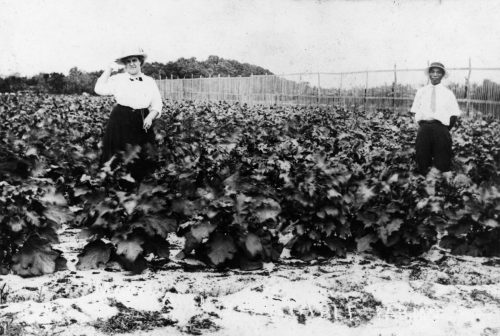
George Morikami on his farm – Yamato, Florida. 1920s. (State Archives of Florida)
March 12, 1925: We took the bus to Miami this morning, a 3-hour trip passing thru the townships of Lake Worth, Del Ray, Ft. Lauderdale, and others including Yamato a little Japanese settlement. Beautiful farms and orchards. The car traveling thru thick jungle hammock along roads shaded by overarching trees. Just before driving in Miami we passed thru [Hollywood?] a fine new development.
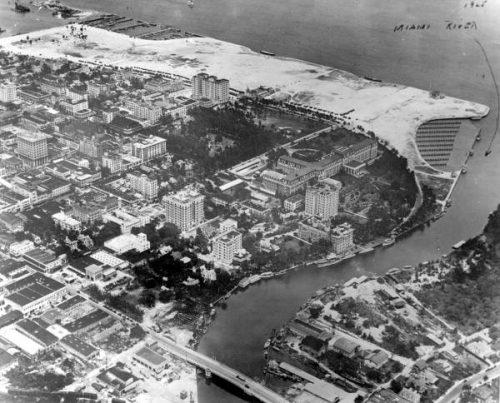
Aerial view of the Miami River and part of the city – Miami, Florida. 1925. (State Archives of Florida)
Miami is the most bustling, active and thriving city I have so far seen in Florida. The streets are absolutely thronged, and the shops all seem very busy. On all sides our [brars?] racing and real estate. The latter is booming miraculously, and men are everywhere offering free rides to advertise their interests. There are many hotels and much building going on constantly. Tonight we stay at the Coconut Grove which faces Biscayne Bay and is strung with orange and green lights. Crowds assemble here to listen to Pryor’s band which plays every afternoon and evening for an hour and a half. This hotel (The Ponce de Leon) is centrally located and is patronized by a rather sporty class of people. There is music and dancing here at night.
Miami
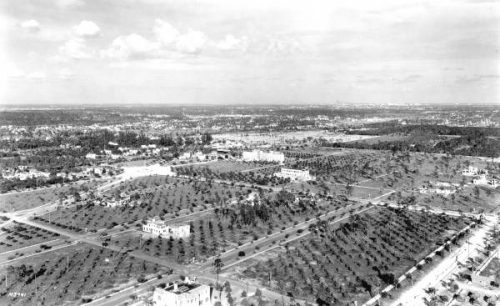
View of Coral Gables from the Miami Biltmore hotel – Coral Gables, Florida. 1925. Photo by William Arthur Fishbaugh, 1873-1950. (State Archives of Florida)
March 13, 1925: We had a most interesting trip in sight seeing bus today, riding around the city proper and many of the suburbs including the beautiful Coral Gables, so extensively advertised throughout Florida and which will be a perfect city in itself when completed, [???] Heights, Allapultah, and a small settlement of negroes who come over from the Bahamas for the winter season. We saw the magnificent houses of many of the millionaires, including that of Ludris[?] Tiffany Weering[?], W. J. Bryan, Arthur Curtis James and many large boarding schools. Bricknell Ave named for one of the earlier settlers is a fine residential street. The red-leaved [?] and orange colored bignouia[?] or flame flower are common about here; we visited a little Seminole Indian village in which the natives, who are dressed in accurate[?] and colorful costumes, rather suggestive of patchwork quilts, elaborately coiffed with strings of beads which cover their entire necks, bare legged and excessively dirty, live in open thatch roofed huts. The men and women dress nearly alike and the children who are numerous, are miniature replicas of the elders. The woman are busy cooking corn and various vegetables over wood fires or sewing colored cotton strips onto dresses on their little machines. There are hundreds of alligators all over and some of which perform tricks, and other animals including turtles, raccoons and monkeys. A canal runs through and irrigates this land, known as Musa Isle, where wonderful oranges, grapefruit, king oranges, tangerines, Spanish limes, and kumquats are grown, there being 1 tree in which all varieties have been grafted. The dead leaves if the washingtonia palm is used to thatch the shelters, which are merely raised platforms, in which the Indians sleep and eat. They make many curious trinkets from coconuts and alligator skins and sell their dresses for masque balls.
Miami
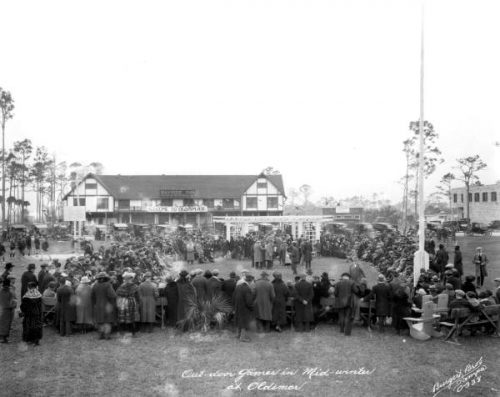
Crowd gathered in front of the Wayside Inn for outdoor games – Oldsmar, Florida. 1923. (State Archives of Florida)
March 14, 1925: We took a walk this afternoon looking at the fascinating specialty shops with which this section is filled. There are many arcades intersecting the streets in which one can escape the heat and glare of the sun which is always string in the middle of the day. Then we say for awhile on the blissful[?] verandah overlooking the park, enjoying the balmy breezes. After dinner, which we took at the Wayside Inn (the most satisfactory restaurant we have struck) we motored to Hialeah, a ride of ¾ of an hour and saw the dog races which were quite amusing, (Ladies free tonight).
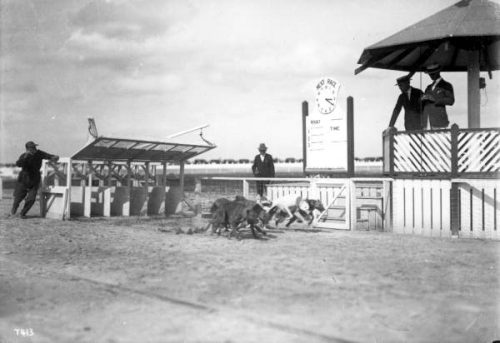
Hialeah greyhound dog races – Hialeah, Florida. 1922. Photo by William Arthur Fishbaugh, 1873-1950. (State Archives of Florida)
The track and grand stand are like those of horse races and the dogs (6 to each race) are brought into the field on leashes by jockeys dressed in variously conspicuous outfits to match those of their dogs. The latter, when released (they are carefully muzzled) chase an electrically propelled rabbit. The band plays between the races which last but a fraction of a minute. The 8th and last race was a hurdle. There were crowds of spectators and much excitement. We returned to the hotel at 1:30 a.m.
Miami Beach
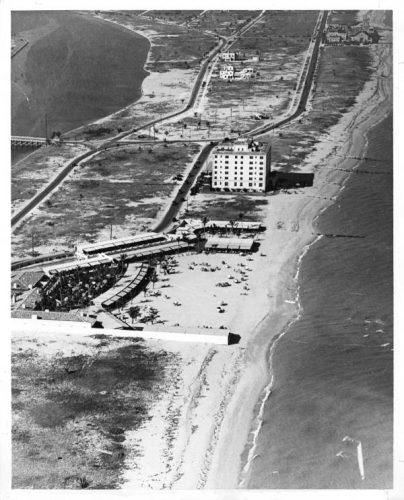
Aerial view of Miami Beach. 1925. (State Archives of Florida)
March 15, 1925: We got a car and spent part of the day at the beach which is separated from Miami City by a beautiful causeway which is linked by bridges to many little and prettily laid-out isles. At the beach where we watched many bathers, we saw the usual palatial houses to which one grows accustomed in this country, and among the many fine hotels and apt. – hotels, the Flamingo, Nautilus and Fleetwood are the newest and most beautiful. The sts. are all wide and flower-edged. There are lovely yachts and house-boats in the bay and ocean and the casino presents an animated scene.
On our return to Miami we drove thru the Villa Viscaya, the supremely beautiful estate of James G. Deering to which the public is admitted Sundays and Wednesdays provided they keep on moving and do not get out of their cards. It is a little bit of fairy land. On one side of the road are the luxurious servants quarters and carefully planned orchards and vegetable gardens. On the other side are miles of everglades interlaced by a network of lakes and lagoons opening into the Biscayne Bay and crossed by curved bridges. In front of the marble [?] is a marble yacht basin and the house and grounds are ornamented with lovely statuary imported from Italy. The grounds have been left as nearly as possible in their natural state and brilliant leaved, tropical wild flowers enliven the green of the trees and the water beneath the brilliant blue canopy of sky.
Miami
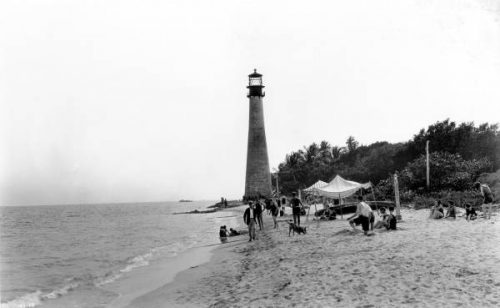
People on the beach by the Cape Florida Lighthouse. 1926. (State Archives of Florida)
March 16, 1925: At 10 AM we took a little yacht and went up the bay as far as Cape Florida where we remained for half an hour and returned to Miami at 1 P.M. It was a quiet restful trip, cool and refreshing. We talked to some very nice people aboard. Going along the coast we viewed the front of the houses of which we saw only the rears in motoring. Along the way we saw many pelicans perched on piles sticking up in the water and schools of porpoises rising to the surface for their prey. Cape Florida, which is really an island, boasts a hundred-year-old light house. Many picnic parties are held beneath the palms and we ate some green coconuts off the trees. We passed another beautiful island on which Mr. Mathison of L.I. has a sumptuous home, more like a club house, where he entertains large parties.
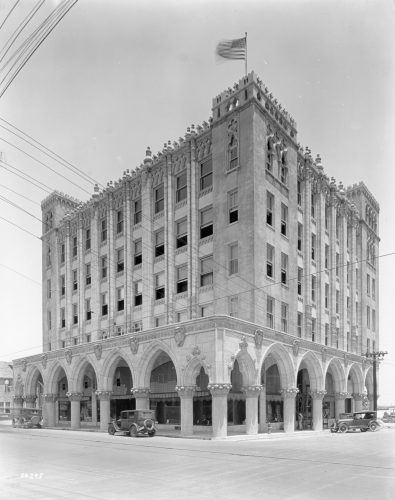
Burdine’s building on Northeast 2nd Avenue at 10th Street – Miami, Florida. 1926. Photo by William Arthur Fishbaugh, 1873-1950. (State Archives of Florida)
On our return we visited Burdine’s department store the largest in Miami and very complete, where we enjoyed a good wall [sarwid?] and a reasonable lunch of the roof, part of which is set with parasol shaded tables.
Thanks for reading “Traveling with Grace,” a series where we’re sharing (and annotating) posts from the travel diaries of Grace Amelia Hecht, native Baltimorean, b. 1897 and d. 1955. Next week we’ll finish up the Florida trip. As mentioned in my introductory post transcription errors sometimes occur and I’ve made my best guesses where possible, denoted by [brackets]. – Rachel Kassman, marketing manager

